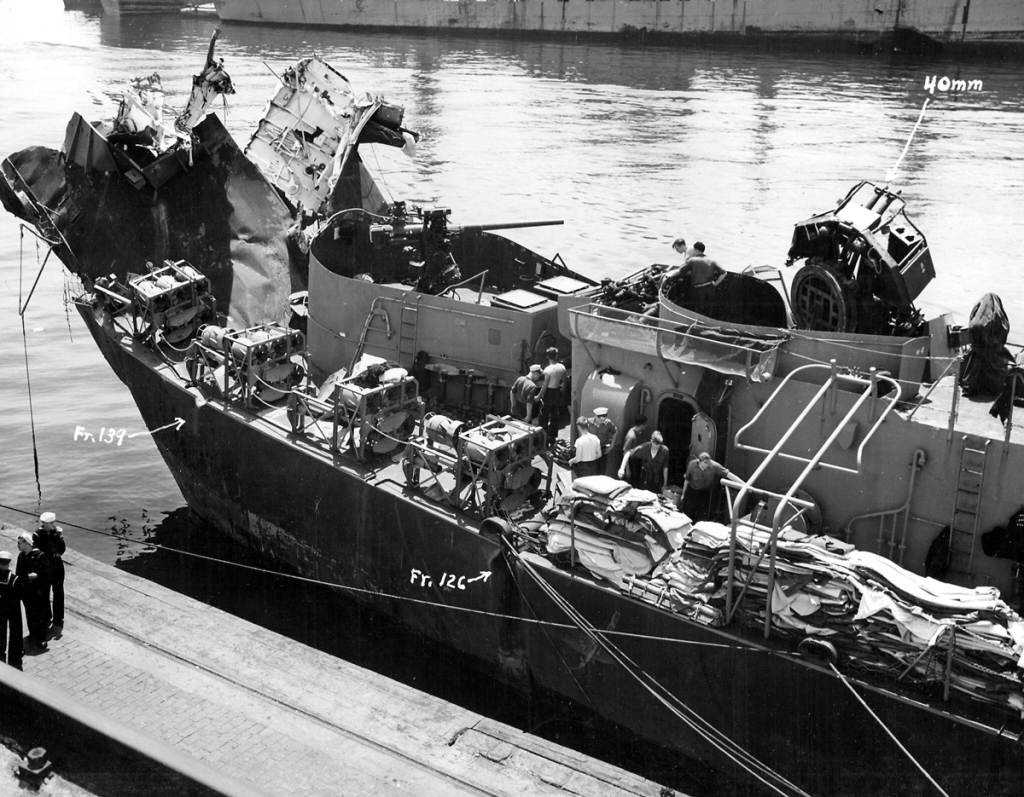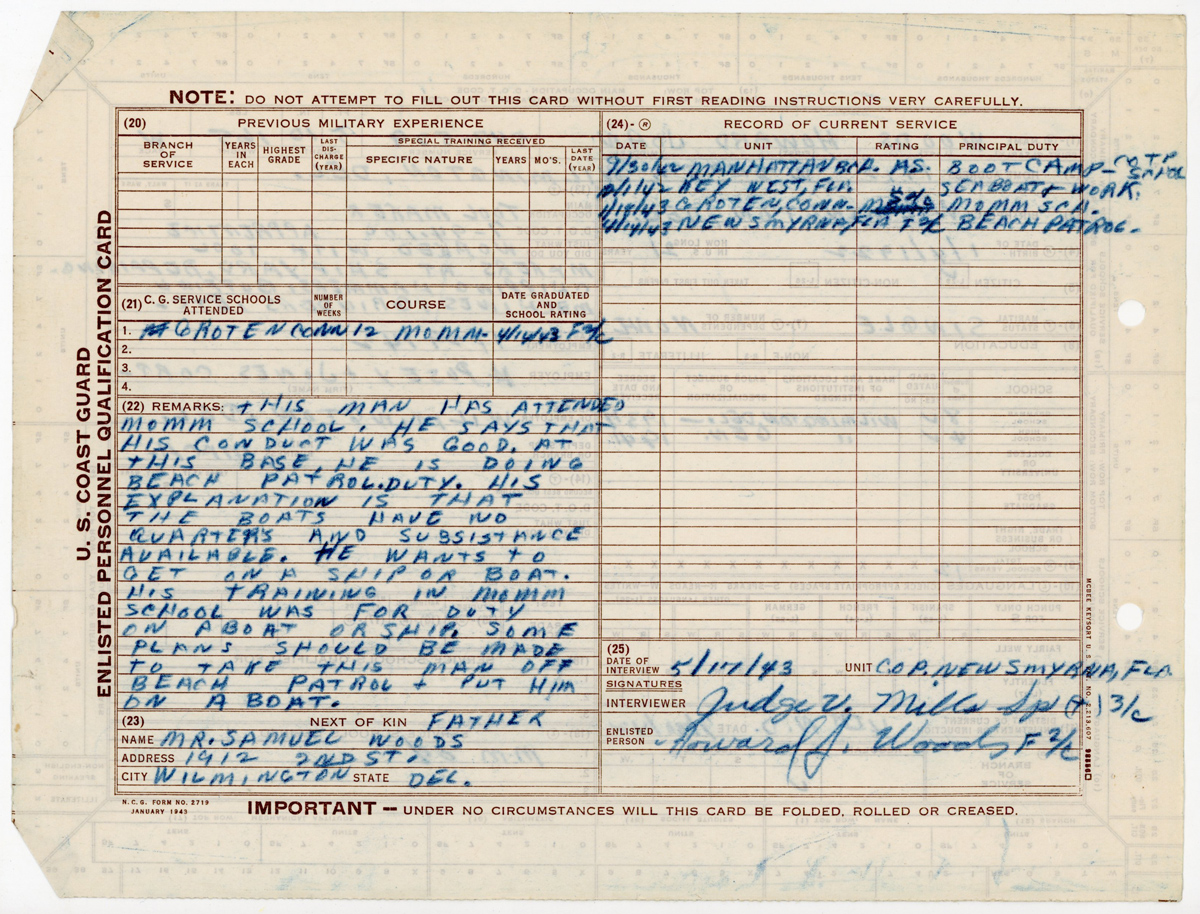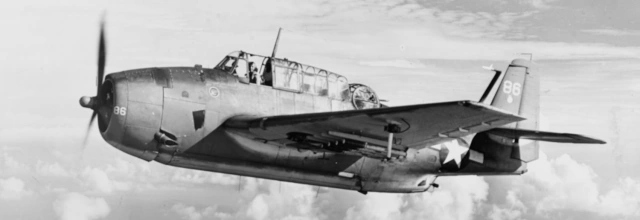| Hometown | Civilian Occupation |
| Wilmington, Delaware | Apprentice toolmaker for Pusey & Jones |
| Branch | Service Number |
| U.S. Coast Guard Reserve | 547-529 |
| Theaters | Vessel |
| American, Mediterranean | U.S.S. Menges (DE-320) |
Early Life & Family
Howard John Woods was born at 129 North Dupont St in Wilmington, Delaware, on January 4, 1922. He was the fourth child of Samuel Robert Woods (a machinist, 1892–1971) and Mary Woods (née Gallagher, 1892–1960). Woods had two older sisters, an older brother, a younger brother, and a younger sister.
The Woods family was recorded on the census on April 16, 1930, living at 2410 West 2nd Street in Wilmington. They were recorded on the next census, taken April 18–19, 1940, living at 1912 West 2nd Street.

Woods attended Lore School in Wilmington through 6th grade, followed by Bayard Junior High School. He played football at Wilmington High School. Woods had average grades, graduating in 1941 ranked 129th in his class of 140. His personnel file stated that he was an apprentice toolmaker at the Pusey & Jones shipyard—where his father also worked—from February 10, 1941, until he entered the service, earning $0.75 an hour. His personnel file described him as standing five feet, 8½ inches tall and weighing 148 lbs., with brown hair and green-gray eyes. Woods was Catholic.
Woods’s younger brother, William Patrick Woods (1924–2011), served in the U.S. Army during World War II.
Coast Guard Career
Woods volunteered for service in the Coast Guard in Baltimore, Maryland, on September 14, 1942. Since he was under 21, the age of majority at the time, Woods’s father consented to his enlistment for a three-year term in the U.S. Coast Guard Reserve. Woods was accepted as an apprentice seaman in Baltimore on September 30, 1942, and placed on inactive duty. He went on active duty on October 2, 1942, when he began boot camp at the U.S. Coast Guard Training Station, Manhattan Beach, New York.
Apprentice Seaman Woods departed Manhattan Beach on November 21, 1942. He reported for duty at Key West, Florida, on November 23, 1942. He was promoted to seaman 2nd class on January 2, 1943, and transferred back north on January 13, 1943. Two days later, Woods reported for Motor Machinist’s Mate School at the U.S. Coast Guard Training Station, Groton, Connecticut. On April 22, 1943, Woods completed his training with a score of 85% was appointed to the rating of fireman 2nd class. The same day, he began a week of leave.

On April 30, 1943, Fireman 2nd Class Woods arrived at New Smyrna, Florida, where he found himself performing beach patrol duty. At a classification interview on May 17, 1943, he expressed disappointment at the assignment given his completion of Motor Machinist’s Mate School, telling the interviewer that he was told there were no available shipboard slots. Although he requested sea duty, Woods remained at New Smyrna until September 21, 1943. The following day, he reported for duty at the Naval Training Station, Norfolk, Virginia. He trained there until October 23, 1943.
On October 26, 1943, Fireman 2nd Class Woods joined the crew of the new Edsall-class destroyer escort U.S.S. Menges (DE-320), which was commissioned that same day at the Consolidated Steel Company Corporation’s shipyard in Orange, Texas. Commanded by Lieutenant Commander Frank M. McCabe (1910–2007), Menges was a U.S. Navy ship but had a Coast Guard crew. Curiously, even though Woods’s fireman rating would typically indicate engine or boiler room duty, a note in his personnel file stated that beginning on November 1, 1943, his duty was mess cook aboard the Menges. The end date of that duty—if there was one prior to his death—was not recorded.


Menges operated out of Galveston, Texas, during sea trials from October 30, 1943, to November 7, 1943, when she sailed for New Orleans, Louisiana. One week later, she departed for a shakedown cruise to Bermuda with a short stop in Burwood, Louisiana. The vessel was at Charleston, South Carolina, beginning December 18, 1944. Woods was promoted to fireman 1st class on January 1, 1944. Two days later, Menges headed north. The ship operated out of Norfolk during January 6–28, 1944, conducting training in Chesapeake Bay.
Finally, Menges began regular convoy escort duty, starting on January 31, 1944, when she escorted part of UGS-32 on the run from New York City to Norfolk, arriving the following day. She then escorted the full convoy across the Atlantic beginning on February 3, 1944. Her commanding officer, Lieutenant Commander F. M. McCabe, summarized the next three months in a postwar service summary: “From 3 February until 3 May, 1944 MENGES was engaged in trans-Atlantic escort duty between New York, Norfolk and the Mediterranean. Ports visited were Gibraltar, Casablanca, Oran, Algiers and Bizerte.”
On March 4, 1944, Menges rescued a man who fell overboard from another ship in a convoy she was escorting. The following month, on the night of April 20, 1944, German bombers attacked the convoy she was escorting through the Mediterranean Sea, UGS-38. Among the men lost that night was another Delawarean, Corporal Joseph M. Vignola (1920–1944) of the 32nd Photo Reconnaissance Squadron, killed when the S.S. Paul Hamilton exploded and sank with all 580 men aboard.


After the air raid, Menges rescued over 100 survivors from the sunken American destroyer U.S.S. Lansdale (DD-426) as well as two downed German fliers. The following day, she landed the survivors at Algiers, Algeria, before rejoining the convoy. On April 22, 1944, Menges arrived in Bizerte, Tunisia.
Duel in the Mediterranean
On May 1, 1944, Menges departed Bizerte as one of 14 escorts for GUS-38, an 81-ship westbound convoy that was to sail through the Mediterranean Sea and on to the United States. Shortly after midnight on May 3, 1944, Menges was positioned 3,000 yards behind the convoy, which was east of Algiers and sailing at nine knots. At 0025 hours, Menges’s radar detected an unidentified vessel six nautical miles astern. The escort division commander ordered her to investigate. World War II submarines could travel faster on the surface than submerged and were harder to spot than most surface ships. For that reason, some submarine commanders attacked even well-defended convoys on the surface at night or moved around the perimeter of a convoy to get in position for a submerged attack after daybreak.
Menges was equipped with a pair of Foxer noisemakers, a countermeasure against German acoustic torpedoes that homed in on the sounds of Allied ships’ propellers. The Foxers were louder than the ships’ propellers and proved highly effective at drawing acoustic torpedoes away, although they reduced the effectiveness of the escorts’ sonar and could not protect the towing ships from every angle.
Menges accelerated to 15 knots, deployed her Foxers, and began zigzagging toward the contact, which had an estimated speed of 14 knots. Her crew manned their battle stations. Fireman 1st Class Woods’s battle station was with Repair Party No. 3. Another member of the same repair party was Fireman 1st Class Joseph Lawrence Hoodock, Jr. (1923–1944), another man from Wilmington.
The contact was indeed a German U-boat, U-371, under the command of Oberleutnant Horst-Arno Fenski (1918–1965). At 0104 hours, Menges accelerated to 20 knots. The moon was nearly full, but her lookouts could see no sign of the enemy submarine. The destroyer escort closed to about 3,200 yards before losing the radar contact at 0112 hours when U-371 submerged. At 0115 hours, Menges decelerated to 15 knots and began searching for the enemy submarine using sonar. Unbeknownst to the Americans, the German submarine had already fired a single G7es acoustic torpedo.
Commander McCabe wrote: “At 0118, a torpedo hit somewhere near the center of the stern with a terrific explosion. […] The explosion carried away both propellers and rudders, and seriously damaged the after 30 percent of the ship.” Menges’s position was approximately 37° 3’ North, 5° 25’ East when she was hit.


31 men were killed in the explosion. Casualties were very heavy among personnel manning the depth charges, torpedoes, and aft guns, as well as those responsible for the Foxer and steering gear. Among the dead were six men from Repair Party No. 3 including Woods and Hoodock.
The crew rushed to repair the damage and treat the wounded. Hours before the attack, Menges’s doctor had been transferred to a merchant ship to treat an injured patient, so Chief Pharmacist’s Mate Harold Levy (1913–2003), who was later awarded the Legion of Merit, treated 25 wounded men virtually singlehandedly until a British doctor was dropped off from the destroyer H.M.S. Blankney the following morning. The British tug H.M.S. Aspirant towed Menges into Bougie, Algeria, where the dead and wounded were offloaded before the ship was towed to Algiers.

In the meantime, American, French, and British destroyers and destroyer escorts swarmed the area, damaging the submerged U-371 with depth charges and hounding her for the next day until the submarine’s batteries became so low that she was forced to surface. The Allied warships pounced on the fleeing submarine. U-371 managed to torpedo and damage the French destroyer escort Sénégalais before suffering such severe damage that her crew scuttled her around 0400 hours on May 4, 1944. Three German sailors drowned and 49 became prisoners of war.
Menges was eventually towed across the Atlantic to New York, where her shattered stern was removed and replaced with one from U.S.S. Holder (DE-401), another destroyer escort that had been out of service since she was torpedoed in April 1944.
Fireman 1st Class Woods was initially buried on May 6, 1944, at a temporary cemetery at El Alia, near Algiers, Algeria. He was posthumously awarded the Purple Heart. Journal-Every Evening reported that the Woods and Hoodock families were notified of the men’s deaths on May 8, 1944.

After the war, Woods’s family requested that his body be repatriated to the United States. After funeral services at his parents’ home and requiem mass at St. Thomas the Apostle Roman Catholic Church on the morning of June 5, 1948, Woods was buried at Silverbrook Cemetery. His parents were also buried there after their deaths.
Notes
Father’s Employers
Although his obituary stated that Samuel Woods “retired in 1958 from the former Pusey & Jones Corp. after 42 years service”—suggesting that he was hired at the shipyard around 1916—his 1917 draft card and the 1920 census listed him as working at the Eddystone Rifle Plant in Pennsylvania (initially built by Remington Arms and later owned by Midvale Steel and Ordnance).
Acknowledgments
Special thanks to the Woods family, the Delaware Public Archives, and NavSource for the use of their photos.
Bibliography
Certificate of Birth for John Woods. Record Group 1500-008-094, Birth Certificates. Delaware Public Archives, Dover, Delaware. https://www.familysearch.org/ark:/61903/3:1:S3HY-6FX7-H1X
Fifteenth Census of the United States, 1930. Record Group 29, Records of the Bureau of the Census. National Archives at Washington, D.C. https://www.ancestry.com/imageviewer/collections/6224/images/4531894_01104
Fourteenth Census of the United States, 1920. Record Group 29, Records of the Bureau of the Census. National Archives at Washington, D.C. https://www.ancestry.com/imageviewer/collections/6061/images/4295771-00727
Green, Arthur. “Narrative by Arthur Green, PhoM2/c, USCG.” Interview on June 28, 1944. World War II Oral Histories, Interviews and Statements. Record Group 38, Records of the Office of the Chief of Naval Operations. National Archives at College Park, Maryland. https://catalog.archives.gov/id/278482612
McCabe, F. M. “Action Report of U.S.S. MENGES on 3 May, 1944 (against enemy submarine).” May 9, 1944. World War II War Diaries, 1941–1945. Record Group 38, Records of the Office of the Chief of Naval Operations. National Archives at College Park, Maryland. https://catalog.archives.gov/id/78527470
McCabe, F. M. “History of U.S.S. MENGES (DE 320).” April 3, 1946. World War II War Diaries, 1941–1945. Record Group 38, Records of the Office of the Chief of Naval Operations. National Archives at College Park, Maryland. https://catalog.archives.gov/id/77667992
McCabe, F. M. “War Diary for Month of April, 1944.” May 10, 1944. World War II War Diaries, 1941–1945. Record Group 38, Records of the Office of the Chief of Naval Operations. National Archives at College Park, Maryland. https://catalog.archives.gov/id/78422314
McCabe, F. M. “War Diary for Month of February, 1944.” March 17, 1944. World War II War Diaries, 1941–1945. Record Group 38, Records of the Office of the Chief of Naval Operations. National Archives at College Park, Maryland. https://catalog.archives.gov/id/78336106
McCabe, F. M. “War Diary for Month of January, 1944.” February 1, 1944. World War II War Diaries, 1941–1945. Record Group 38, Records of the Office of the Chief of Naval Operations. National Archives at College Park, Maryland. https://catalog.archives.gov/id/78276466
McCabe, F. M. “War Diary for Month of May, 1944.” June 1, 1944. World War II War Diaries, 1941–1945. Record Group 38, Records of the Office of the Chief of Naval Operations. National Archives at College Park, Maryland. https://catalog.archives.gov/id/78448843
“Military Rites Planned For Howard J. Woods.” Journal-Every Evening, June 2, 1948. https://www.newspapers.com/article/134953230/
Official Military Personnel File for Howard J. Woods. Official Military Personnel Files, c. 1898–c. 2004. Record Group 26, Records of the U.S. Coast Guard. National Archives at St. Louis, Missouri.
“Samuel R. Woods.” Evening Journal, June 9, 1971. https://www.newspapers.com/article/134385175/
Sixteenth Census of the United States, 1940. Record Group 29, Records of the Bureau of the Census. National Archives at Washington, D.C. https://www.ancestry.com/imageviewer/collections/2442/images/m-t0627-00552-00663
“Three Added to List of Heroic Dead.” Journal-Every Evening, May 9, 1944. https://www.newspapers.com/article/100305052/
Van Nostrand, Leroy Jr. “Battle Report of Submarine Attack on USS MENGES, 3 May, 1944.” May 4, 1944. World War II War Diaries, 1941–1945. Record Group 38, Records of the Office of the Chief of Naval Operations. National Archives at College Park, Maryland. https://catalog.archives.gov/id/78527470?objectPage=4
World War I Selective Service System Draft Registration Cards, 1917–1918. National Archives at Washington, D.C. https://www.ancestry.com/imageviewer/collections/6482/images/005207041_02205
Woods, Samuel. Individual Military Service Record for Howard John Woods. Undated, c. 1946. Record Group 1325-003-053, Record of Delawareans Who Died in World War II. Delaware Public Archives, Dover, Delaware. https://cdm16397.contentdm.oclc.org/digital/collection/p15323coll6/id/21493/rec/2
WWII Draft Registration Cards for Delaware, October 16, 1940 – March 31, 1947. Record Group 147, Records of the Selective Service System. National Archives at St. Louis, Missouri. https://www.ancestry.com/imageviewer/collections/2238/images/44003_04_00010-01245
Last updated on November 19, 2023
More stories of World War II fallen:
To have new profiles of fallen soldiers delivered to your inbox, please subscribe below.










